I left our own Kirk Hamilton with a challenge when we last discussed one of the greatest games of all time — a game he had never played: “Let’s not do it again until you see Samus’ face.”
Ladies and gentlemen, people of exquisite taste, I am happy to tell you that Kirk has seen the face of Metroid Prime‘s bounty-hunter hero Samus Aran. Kirk has discovered the clever way that this first-person game from 2002 managed to show you the face of the helmeted, visor-wearing character whose perspective you inhabit as you play the game.
And so we can continued talking Metroid Prime. It is decreed.
What follows is what we expect to be the middle chunk of my and Kirk’s heavily-illustrated discussion about how a game released more than a dozen years ago holds up so well in a medium that renders most of its supposedly best works obsolete in half that time.
Note: This conversation starts all light and happy but gets kinda deep! You’ve been warned.
Stephen: Kirk! You’ve seen Samus’ face! I was very excited that you met my challenge and played enough Metroid Prime to see her face. Good moment, huh?
Kirk: So good. That was like… argh, can I call it “video game magic” without sounding like a total doof? I’m not sure what I was expecting, but I wasn’t expecting that.
Stephen: And that’s when you knew: this is a very good video game. That was something we were talking about last time, that you had a good first impression of it but were still sort of relying on other people’s assessments of it being an all-time great. You’re further in now and are a True Believer, yes?
Kirk: Yep. True Believer, over here. This game is amazing.
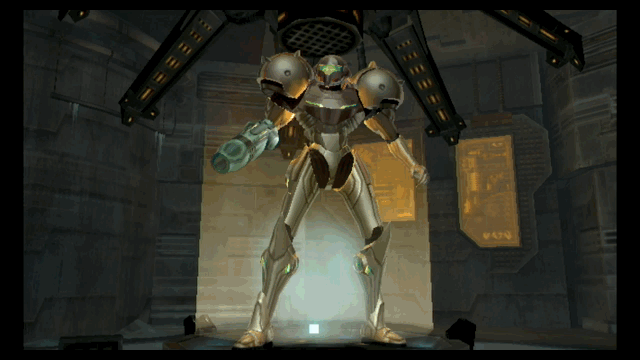
Stephen: You’re how far in? The other night, I ripped through a few hours’ worth and got the boost ball, the space jump boots, the super missile and the wave beam in short order.
I was amazed at how much I didn’t mind it sending me all around the game world to get those things, by the way…
Kirk: I’m pretty far. I’ve gotten all those upgrades, plus the thermal visor, the spider ball, and… I believe the ice beam was the last thing I got. I fought my way through the space pirate outpost to get the thermal visor, which I would describe as the “shit gets real” part of the story — that’s where you first learn of the space pirate plan to enhance Metroids with Phazon, and where you first run into actual Metroids in their holding tanks. From there, the gameworld seemed to completely explode on me — I defeated Thardus the rock beast (paging Galaxy Quest!), then found myself almost sprinting through new sections of Magmoor Caverns, Phendrana Drifts, and back to the overworld with no chance to catch my breath or get my bearings. Then I was underwater, with Samus’ gaze reflecting back at me. It’s a lot to process. Basically, right when I thought I had a handle on the map, the game expanded in six directions at once. I’m a little overwhelmed.
Stephen: Oh yeah, I got the thermal visor, too! I forgot about the weird noise it’s always making.
Kirk: Yeah, it gets in the way of the soundtrack.
Stephen: The visor stuff was amazing when Prime first came out, but I think it’s been done in so many games since then that it loses some of its impact. It’s very stylishly implemented, but it’s not much of a novelty in an era of night-vision/Detective-vision/Eagle-sense modes.
Kirk: That’s true, but the scanner, at least, still feels distinctive to me. I think it’s how it feels to use it, how you still have to aim it at things. I’m completely won over by the scanning in this game. I can see why you like it so much.
Stephen: I just got the badge for scanning 50% of scannable things last night!
I am struck by how artistically rich the game is and yet by how cleanly designed its rooms and zones are. It’s very easy to “read” any room you go in. And that in turn helps me move through the game stupidly fast. You get the boost ball in Phendrana, then have to go all the way out to the Tallon Overworld, do the crazy half-pipe stuff (nice surprise, huh?) to get to the spot where you get the Space Jump Boots, just to have to go back to right where you were in Phendrana. But I didn’t care, because a) I can move through the world so fast, b) it feels good to move through the world thanks to the game’s amazing jumping and morph ball physics and c) there’s so much you can grab in these rooms as you go through them — so many hidden things that are fun to find.
Kirk: I could spend 1000 words on each thing I like in this game. I’ve been keeping it all in in anticipation of this chat, and now I want to go 100 directions at once!
The feel of those half-pipes! It took me a minute to figure out how to use the boost ball just /so/, and the feel of this game is just so good… it lands squarely between buoyancy and precision.
And yeah, I’m impressed that the rooms can be so clear and easy to read, yet can still hide so many secrets. Though a lot of them aren’t really “secrets,” right? The game tells you they’re there but helps you understand that you can’t quite reach them. As a result, I’m trying to keep this elaborate log of mental bookmarks of the various areas that I need to revisit, but there are just a FEW too many for me to remember. The end result is that I’m constantly aware that there are any of a half-dozen or more things I could probably be doing, and it’s beneficial for me to simply re-explore.
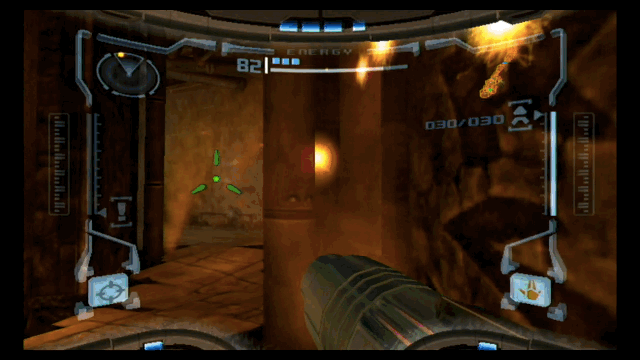
I’ve thought a few times how this game feels a little bit like an amusement park attraction. I don’t mean that in the way it’s usually used by game critics, like, how people will knock BioShock Infinite by saying it feels like Disneyland. It’s partly the old tech — the way you’ll walk down a hall to Magmoor Caverns and these red jets of steam will blast your visor to set the mood… it feels like a theme park entryway, but it somehow works.
And, yeah, it seems like a conscious design decision to have you go back to the overworld to unlock the jump boots. Up until then, I’d been unlocking everything by going progressively deeper into new areas, but that was the first time (I think?) that the game said “Actually, to go forward, you’re going to have to go backward.”
Stephen: One of the things I love about the boost ball half-pipes is how unexpected they are and yet how well the game has imprinted in your memory this idea that there are these curiously-smooth, curved surfaces on the planet. You get the boost ball, are required to use it in a half-pipe and suddenly you remember two or three other areas that you’ve gone through that — holy shit — they had half-pipes in them!
Kirk: And just in case you forget, Samus’ computer will remind you. “Hey, uh, I noticed this half-pipe when we came in?” Samus’ computer is a skater at heart.
Stephen: Ha.
So you have noticed the audio cues I talked about last time, right? That warbling hum you hear in a room when there’s a hidden pick-up nearby?
Kirk: I have. I finally got myself primed to notice them and figure out where they’re coming from. Which can be frustrating, because some of them are still unreachable with my current gear. They do help me add more bookmarks to my mental log.
Stephen: Primed!
Kirk: Totally on purpose!
(maybe)
Stephen: Yeah, scanning usually tells you whether you can reach something or not. Don’t have something that shatters brinstone or whatever? Then don’t bother.
We’ve discussed this outside of the chat, but I was happy that we both played around with the controls and the lock-on stuff.
Kirk: Yeah, I wasn’t expecting so many options.
Stephen: I am perhaps foolishly fixed on the idea that whatever the game’s creators intended for their game is probably best. Prime was a GameCube game. Using Wii controls with a “loose” lock-on — one where you still have to finesse the aiming of your shots — instead of a hard lock-on that the GameCube controllers gave you felt weird. This is, in my mind, not a game about aiming skill. Or at least MP1 and 2 weren’t. It’s a game about a badass bounty hunter who is going to hit whatever she aims at. So I’m happy that the Wii U/Wii re-release we’re playing lets you switch back to the hard lock.
Kirk: I’d found myself feeling a little bit annoyed by the combat in some early sections, particularly when taking on those turrets in the central tower area of Magmoor Caverns. The problem, for me, was that the game is low-res enough to get blurry at a distance, and I was having to aim at turrets I couldn’t quite see.
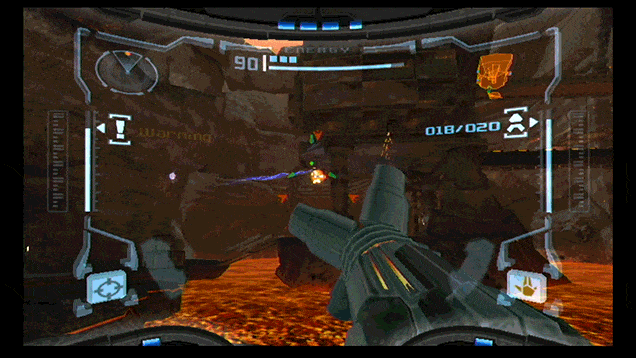
That problem crops up a lot, where enemies feel a bit too small for standard aiming. It’s still doable, but it makes a lot of sense that they were originally designed for true lock-on aiming. I’ve found that lock-on aim and “advanced” movement controls work perfectly for me. And now that I’ve got my Wii U sensor bar set up directly in front of where I hold my Wiimote, this game’s controls have really come together.
Stephen: And, to be a little critical, it’s not like the enemy movement patterns or overall intelligence is all that interesting to engage. So a fire-and-forget system feels right. I don’t feel like I’m cheating my way through a firefight with some Halo-smart enemies, you know?
Kirk: Right — the space pirates feel like the most dynamic enemies, but even those are a bit strange. They get stuck in odd parts of the room and never seem all that challenging. Even the bosses aren’t actually very difficult, but I don’t sense they’re really meant to be. Plus, at this point, I’ve boosted Samus’ health to the point that it’d take a HELL of a fight for her to die. I’ve only died once in my entire time playing the game, and that was when I decided to see what would happen if I sprinted through Magmoor Caverns in my starting suit.
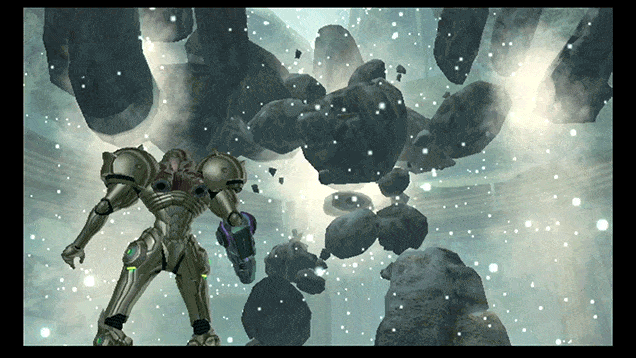
In some ways Prime reminds me of Dark Souls, at least in how the map honeycombs into itself, but one way it’s different is in its difficulty. I’ve gotten more into difficult games lately, but it’s a real pleasure to play one that’s just not “hard” in that way. It’s just consistently, pleasingly engaging. Do you like that about this game? That the “challenge” is more in your head, and less at your fingertips?
Stephen: I’ve never been a twitch-reflex gamer. I grew up with Nintendo systems and was a Zelda person more than I was a Mario person. I liked Metroid over Mario Kart, Advance Wars over Smash Bros. I like games that I can think my way through, and that’s what Prime gets me. It’s a little disappointing when a boss battle starts, because I prefer spending my time as a space archaeologist and sci-fi detective over my time as a space monster hunter.
Can I throw some stuff out at you, though? To get your gut reaction?
Kirk: Sure!
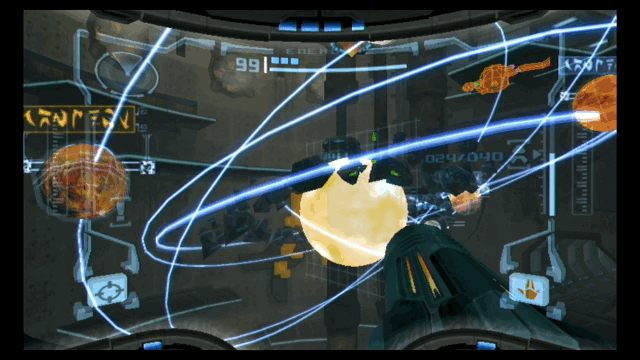
Stephen: The observatory….
Kirk: …was so cool. I looked at every planet more than once, and tried to learn all their names. Seems important!
Stephen: The rocket troopers!
Kirk: The flying guys? They’re annoying, especially in how they suicide-bomb you when they die.
Stephen: Oh, that’s the best.
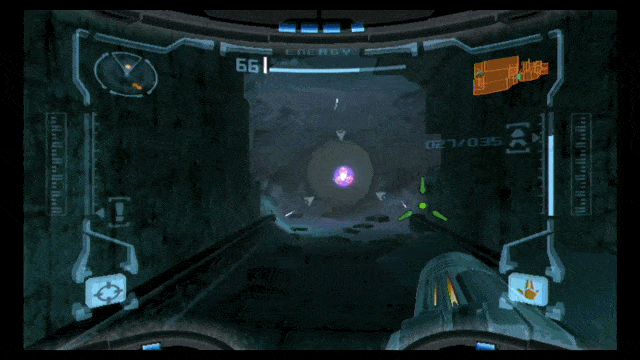
The enemies that make your visor freak out and go to static…
Kirk: …were a drag until I figured out that I could blow them up with my wave beam. Though the underwater guys who suck you in and make you fall back to the bottom of the underwater room…. blarg.
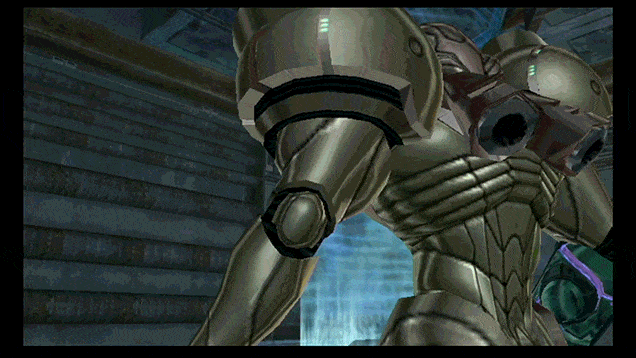
Stephen: Your first fight with a Metroid…
(I wondered if you’d noticed that a game called Metroid had been missing Metroids)
Kirk: …was surprisingly tricky! Those things can take a beating. I killed it with missiles before it got ahold of me, though — I have yet to be glommed by a Metroid.
Stephen: I have one more for you…The platforming…
Kirk: Good, but bad underwater. For the most part I love jumping in this game, with the exception of the underwater section I alluded to earlier. I must’ve fallen to the bottom of that stupid place ten times, which eventually just felt annoying. The platforming is tricky enough on its own, so the enemy that deliberately sucks you off of the platform you’re standing on is too much.
Stephen: Hmm. I wonder if there’s an upgrade later that makes underwater platforming easier and if the justification for it being tough now is that you’ll appreciate the upgrade more.
Kirk: That wouldn’t surprise me — I got the sense that I was going deeper into the water section than I was meant to. Often in this game, when something feels hard, some upgrade or other makes it easier.
Stephen: Yeah. I was glad to hear you got the spider ball, which is one of my favourite upgrades in the series.
In terms of how the upgrades work, I had this really good moment in Magmoor Caverns. I’d run through it a few times and had to do this bit where you roll into a ball, go under the floor and have to roll past some little crab enemies who will try to grab you in their pincers and toss you back to the room’s entrance. You beat them by rolling past them or by tricking them into eating a bomb. But then I got the space jump (the double jump, as you know)… and I’m running back toward that room and vaguely remembered that there’s a fence — not a wall — in the middle of the room. I thought: What happens if I don’t roll into a ball and go under the floor and, instead, if I just run over the floor and try to double-jump that fence? Sure enough, I was able to clear that jump and now know I no longer need to slowly and carefully roll through that room. I can now just run and jump through it. I love that, and it’s no wonder that the Prime games have been favourites of speedrunners.
Kirk: Or the stalactites you can shoot to make little islands, that kind of thing. There’s this organic unfurling that happens along with your upgrades, where it feels like the levels are a big elaborate lock, and you’re the key.
Stephen: Yeah, though that brings me to my moment of doubt, Kirk.
Kirk: Oh no. Doubt!
Stephen: I love the Metroid Prime games, but I’m suspicious of my appetite for games that are empowerment fantasies. Basically, I’ve at times had an inferiority complex about not playing or excelling at games of skill, games you become more capable in through effort and practice. I’ve figured that, because I love to play so many games — and don’t play any of them the multiple times it takes to become better than average at them — that I usually don’t train myself into being a top player.
I think that I wind up enjoying the sort of artificial empowerment that comes from games that — rather than you getting better at them — simulate you getting better at them by making you more powerful as you play. Obviously, Metroid Prime isn’t the only game that lets you become empowered. It doesn’t even have RPG-like levelling, so it’s not a Diablo or Final Fantasy that is gradually raising your power through a mathematical formula. You are, nevertheless, pretty much playing a crafted experience that is designed to make you go from feeling fairly helpless to extraordinarily capable and powerful. As enjoyable as that ride is, well, playing off your theme park analogy before, how much of it is just a ride?
Carrying this thought through, while I don’t feel too weird or dopey playing through an empowerment thrill ride the first time, what does it mean if I go back more than a decade later to do it again? Am I just some weird masochist who likes to play simulated hardship so that I can enjoy programmed and plotted progress? Isn’t that kind of weird and in a way hollow?
Kirk: I hear you. Prime is a very guided experience, and a lot of the time it feels like it’s solving puzzles for me. And if I dawdle for too long, my computer pipes up and tells me where to go next.
I compare that with, say, my first time up against some of the deadly, entirely unexplained encounters in one of Destiny‘s raids, or with one of the many hellacious areas in Dark Souls. Or a particularly tricky dungeon puzzle in a Zelda game, for that matter. They’re different.
Metroid Prime is certainly a pleasurable game to play. But that pleasure, for me, isn’t derived from a sense of overcoming adversity. It’s from watching it all come together, that sense of discovery and wonder. This game makes me feel like I’m solving a mystery as I progress, but it’s the mystery itself that I’m attracted to, not the solution. The feeling of becoming more powerful is appealing, but it’s secondary, at least for me.
I get why you’d question your desire to replay it, but actually, I think that wanting to replay this game makes more sense than replaying something where the primary appeal is the sense of accomplishment from solving difficult puzzles and overcoming tough enemies. You can’t figure it out again for the first time, you know?
While you know what’s coming next and I don’t, I’d say Prime’s appeal goes beyond the satisfaction of conquering or “solving” it and more into the realm of aesthetics. It’s a beautiful place to be, and it’s beautiful to watch it slowly blossom out of itself. Who wouldn’t want to re-experience something beautiful?
Stephen: Thank you for helping me feel better about myself!
You’re right, but just to a degree, because I’d be lying if I didn’t say that I wasn’t disappointed to know that I only had one more visor to get or two more types of laser beams to collect or whatever. I definitely enjoy that empowering part of the game.
That said, I enjoy how the things I find in the game empower me to explore the world more thoroughly, how they enable me to literally see things I couldn’t see before. That’s different from a game that just empowers you to pretend-kill better. I do love being in this world again, and I’m eager to play the two sequels and see how well their aesthetics and mysteries — as opposed to simply their own thrill rides of empowerment — hold up.
You’re going to play this one through, right?
Kirk: Yeah, definitely. I’m planning to play the whole trilogy at this point, really, though it might take me a while. I hadn’t anticipated I would like this game as much as I do — it’s better than anything else I’m currently playing. I know people bag on the sequels, but I’m still curious about them. (And I feel like even an “awful” sequel to this game would still be better than most games.) So yeah, I’m in for the long haul!
Stephen: Nice. For a time I preferred 2 to the original, and I remember liking the third game a lot — but only after the first few hours. We’ll see how they do. Let’s do this again when we both finish the first. Deal?
Kirk: Deal! I still have a million things to say about this game, and I’m sure I’ll have a million more by the time I finish. It’s so good. I’m really glad I’m playing. To be continued.
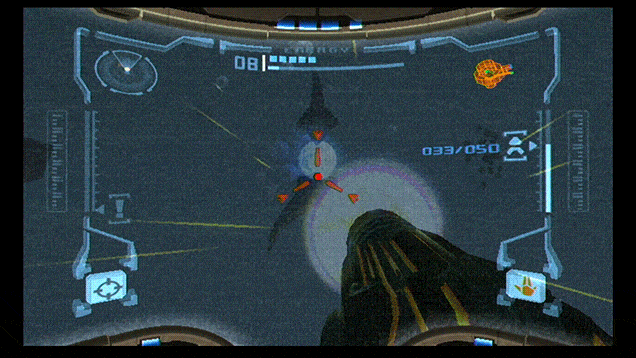
Comments
4 responses to “He Saw Her Face – Why We Still Love Metroid Prime”
You know, when you think about it, you shouldn’t be able to see her face in the reflection.
Man, they love Prime so much. I’d love to see their reaction to Other M.
If you’ve ever had glasses you may or may not be aware that if you don’t get an anti-reflective coating on them then you will be able to see your own eyes (and other parts depending on size and shape) in them, especially when strong light hits your face. If Samus didn’t get it put in then seeing her reflection makes sense. Of course, this is the future so why it isn’t a default is beyond me.
Just went and pulled out my Game Cube to give this another crack. Can’t find a controller though!!! Arrggg…
When I bought my Wii, my first console in ages, I bought the GameCube versions of Prime 1 and 2. Absolutely loved them, and 3. Then the Trilogy temped me on the Wii, and now it is again on the Wii U, but too little time to play the backlog. Ahhh…
Can we get a concluding piece to this please?